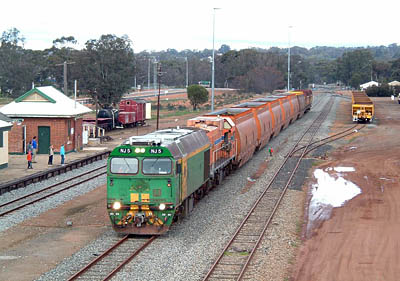
Photo: Phil Melling

Despite its physical isolation from the rest of the Australian railway network, locomotives and rolling stock were exchanged between the Port Lincoln Division and the other narrow gauge divisions of the SAR on a frequent basis. Following the merger of SAR with ANR in 1978, and the privatisation under ASR/ARG/GWA from 1997, these transfers became even more wide-ranging.
The examples below illustrate just a few of the Port Lincoln expatriates, as well as items elsewhere in Australia which eventually found their way to Eyre Peninsula.
| Narrogin, WA. After twenty-one years on Eyre Peninsula, NJ5 moved to Western Australia in 2003 where it is now usually found on the Albany woodchip shuttle. On 12 July 2004 NJ5 hauled a dead AB and the woodchip rake through Narrogin, en route to Perth for workshops attention. |

|
|
Photo: Phil Melling |
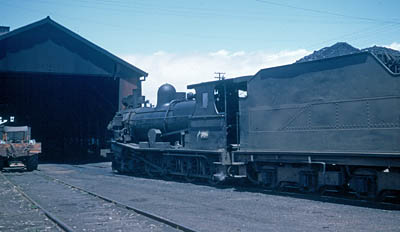
|
Terowie, SA. T185 worked on Eyre Peninsula from 1956 to 1963, then returned to the Peterborough Division for its final years of service. It is seen at Terowie in January 1970, still sporting the 'banjo' sandbox which was characteristic of Port Lincoln Ts.
Photo: Peter Knife |
| Alice Springs, NT. NT74 is seen leaving Alice Springs with the southbound 'Ghan' in March 1970, fourteen years before it was sent to Eyre Peninsula. It then spent three years working out of Port Lincoln, before final withdrawal. |
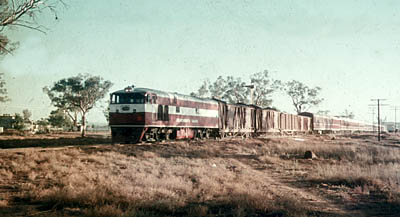
|
|
Photo: Peter Knife |
| Darwin, NT. NT69 was still hard at work in Darwin in April 1970. It made its way to Port Lincoln along with NT74 in 1984, and lasted in service until 1989. |
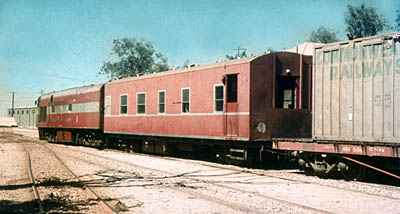
|
|
Photo: Peter Knife |
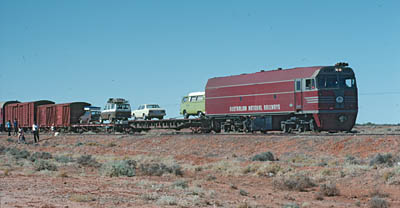
|
Edwards Creek, SA. The NJ class were acquired by the Commonwealth Railways for the Central Australia Railway, and NJ3 is seen on the northbound 'Ghan' at Edwards Creek in October 1980. Four months later it was at work on the Port Lincoln Division, where it remains to this day.
Photo: John Dennis |
|
Burnie, Tas. One past, one future. 852 was delivered new to Port Lincoln in 1963, and worked there until 1985 when it was sent to Tasmania. It is seen here shunting at Burnie in January 1987. 852 returned to the mainland in 1993, where ran on broad and standard gauges. It spent time at Whyalla before being sent to Western Australia in 2006.
The wagon coupled to 852 is Tasrail hopper HA33, formerly an NHA class iron ore hopper on the North Australia Railway. It went to Tasmania in the early 1980s, and in 1996 it was transferred again, this time to Eyre Peninsula where it was intended to become an extra ENHA gypsum hopper. In 2003/4 however it moved again, to Western Australia, where it is once again hauling iron ore as an AHAF hopper. |
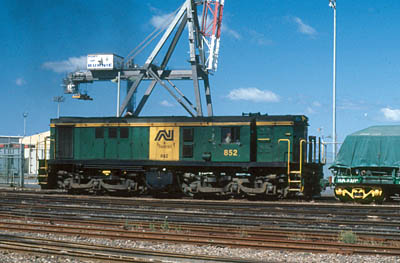
|
|
Photo: Peter Knife |
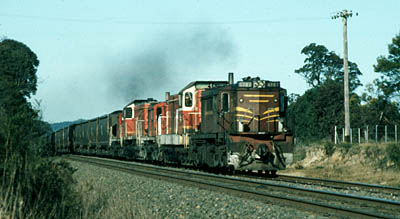
|
Menangle Park, NSW. Tucked away as fifth unit in this lashup of three 48s and two 49s at Menangle Park in August 1991 is 4813. This loco was later bought by Australian National, who 'kitbashed' it (using the long hood from 870) into DA7. On its release to traffic in 1998 it became the first loco on Eyre Peninsula to carry the new colours of Australia Southern Railroad.
Photo: Peter Knife |
| Peterborough, SA. Inspection car MIC 127 spent time on Eyre Peninsula, although it was painted cream with red bonnet stripes during its stay. Later transferred to the Peterborough Division, it is seen here in 2001 beautifully restored by Steamtown at Peterborough. |
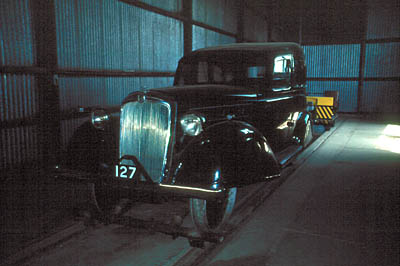
|
|
Photo: Peter Knife |
|
Edwards Creek, SA. Commonwealth Railways' narrow gauge Toyota inspection car MIC-7 was adapted for rail use by the SAR's Islington Workshops in 1969, and saw service on the old Central Australia Railway. It is seen here on 23 October 1980.
CR MIC-7 was renumbered MIC-9 in the SAR series and transferred to Port Lincoln, but herein lies a mystery. Official documents state that it entered service at Port Lincoln on 20 November 1979, yet this photograph clearly shows a Toyota MIC on the Central Australia line eleven months later. Either the transfer date was incorrect, or an ex-SAR Toyota (there were three) assumed its identity on the CAR for the last twelve months until closure of the old 'Ghan' line. Further details will be posted if the mystery is resolved. |
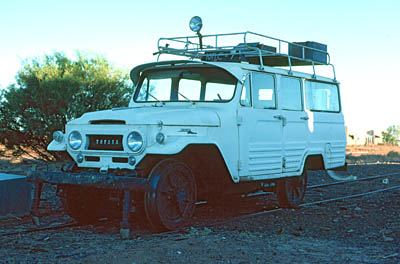
|
|
Photo: John Dennis |
